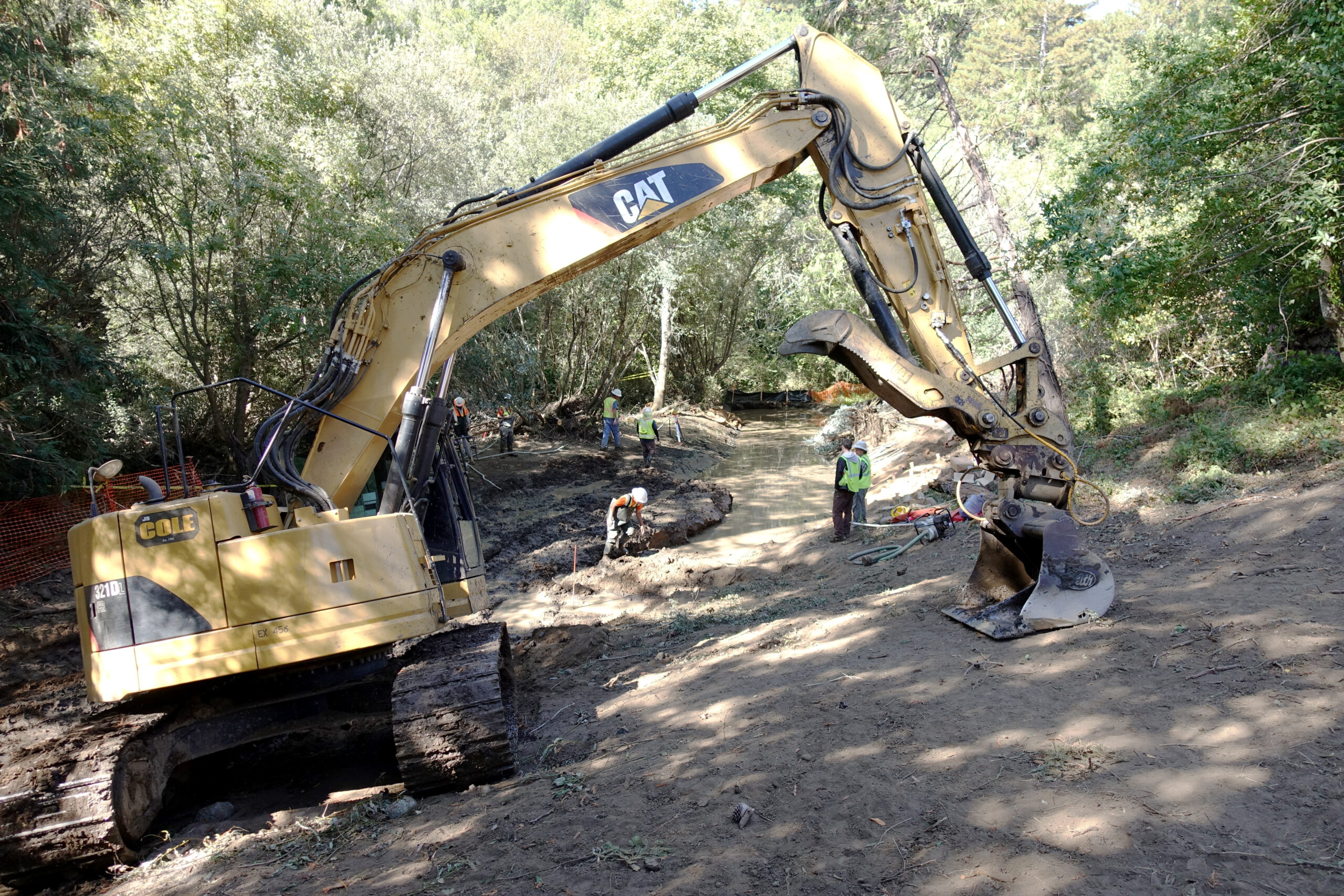FOR IMMEDIATE RELEASE
May 14, 2019
Press Contacts: Preston Brown, Watershed Conservation Director, (303) 877-0880, preston@seaturtles.org
Audrey Fusco, Native Plant Nursery Manager, (415) 845-4790, audrey@seaturtles.org
Todd Steiner, Executive Director, (415) 488-7652, tsteiner@seaturtles.org

The Salmon Protection And Watershed Network was awarded more than $500,000 for the second phase of their floodplain restoration project. The project builds off the successful first phase of the project, which occurred a mile downstream in 2018 and saw the removal of more than 13,000 cubic yards of dumped fill and abandoned structures from the ghost town of Tocaloma.
OLEMA — The Salmon Protection And Watershed Network (SPAWN), a program of the national environmental organization Turtle Island Restoration Network, was awarded a competitive grant on Monday to improve habitat for endangered salmon on Golden Gate National Recreation Area lands along Lagunitas Creek.
The award, totaling $593,040, was one of 38 grants awarded statewide, and the only grant awarded for work in Marin County for multi-benefit ecosystem restoration and protection projects under California Department of Fish and Wildlife Proposition 1 and Proposition 68 round of grant programs.
The award is for the ‘Lagunitas Creek Floodplain Restoration for Coho Recovery, Phase II’ project, designed to reconstruct destroyed floodplain wetlands in the ghost town of Jewell, located just downstream of Samuel P. Taylor State Park between Lagunitas Creek and Sir Francis Drake Boulevard. The project builds off the successful first phase of the project, which occurred a mile downstream in 2018 and saw the removal of more than 13,000 cubic yards of dumped fill and abandoned structures from the ghost town of Tocaloma.
“The goal of this project is to ensure Coho salmon remain part of our landscape for generations to come,” said Preston Brown, SPAWN’s watershed conservation director. “In addition, the project will restore the wild and dynamic nature of Lagunitas Creek and provide benefits to several endangered species and improve water quality.”
The project aims to recover a lost floodplain that has been buried under dirt that was dumped in the creek corridor decades ago to build the village of Jewell. The project will remove 6,000 cubic yards of fill, concrete, and construction rubble, add several pieces of large woody debris, replace non-native invasive plants with native species, and create critical side-channel habitats for coho salmon and other endangered species. The derelict buildings were removed by the National Park Service in 2016.
“We are excited to add several thousand native plants to the area that we have been growing in our native plant nursery, from around 100 species which we have chosen specifically for this amazing spot on Lagunitas Creek,” said Audrey Fusco, SPAWN’s plant ecologist and native plant nursery manager. “Our plants are healthy and ready to go thanks to the volunteer power of thousands of community members that have nurtured the plants for the past few years. Many of these students and volunteers will help with the planting this upcoming winter. This project will improve habitat for many species of wildlife in addition to Coho, fight climate change, and protect biological diversity.”
“Restoring the floodplain along the creek will re-create the large, dynamic wetland with off-channels, alcoves, and numerous large woody debris structures—all elements that Coho salmon critically need for recovery,” said Todd Steiner, executive director of Turtle Island Restoration Network. “These habitats will create slow off-channel areas that are commonly seen in undeveloped pristine waterways that provide spawning, feeding, and rearing habitat for fish and other threatened wildlife including California freshwater shrimp and California red-legged frog.”
###
Turtle Island Restoration Network is a leading ocean and marine wildlife conservation non-profit. Its program, the Salmon Protection And Watershed Network (SPAWN), protects endangered, wild Coho salmon and the forests and watersheds they need to survive in West Marin County, California. Learn more at www.seaturtles.org/salmon.
Also see:
Restoration Activates Channels and Floodplains in Lagunitas Creek this Winter
Before-and-After Photos Show Impressive Progress of Lagunitas Creek Restoration
Dam Release, Rain Brings Flowing Water to Floodplain Side Channel for First Time
Tocaloma Restoration Project: Phase 1 Complete!
Massive Lagunitas Creek Restoration Breaks Ground to Benefit Endangered Salmon




